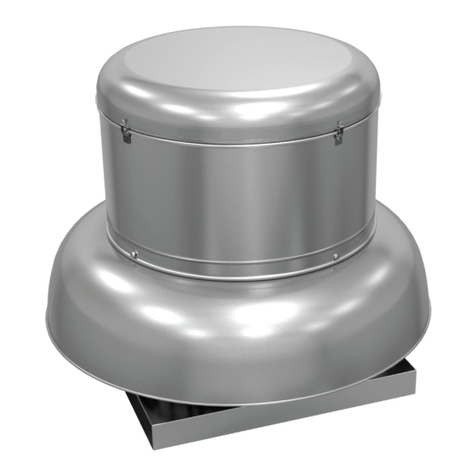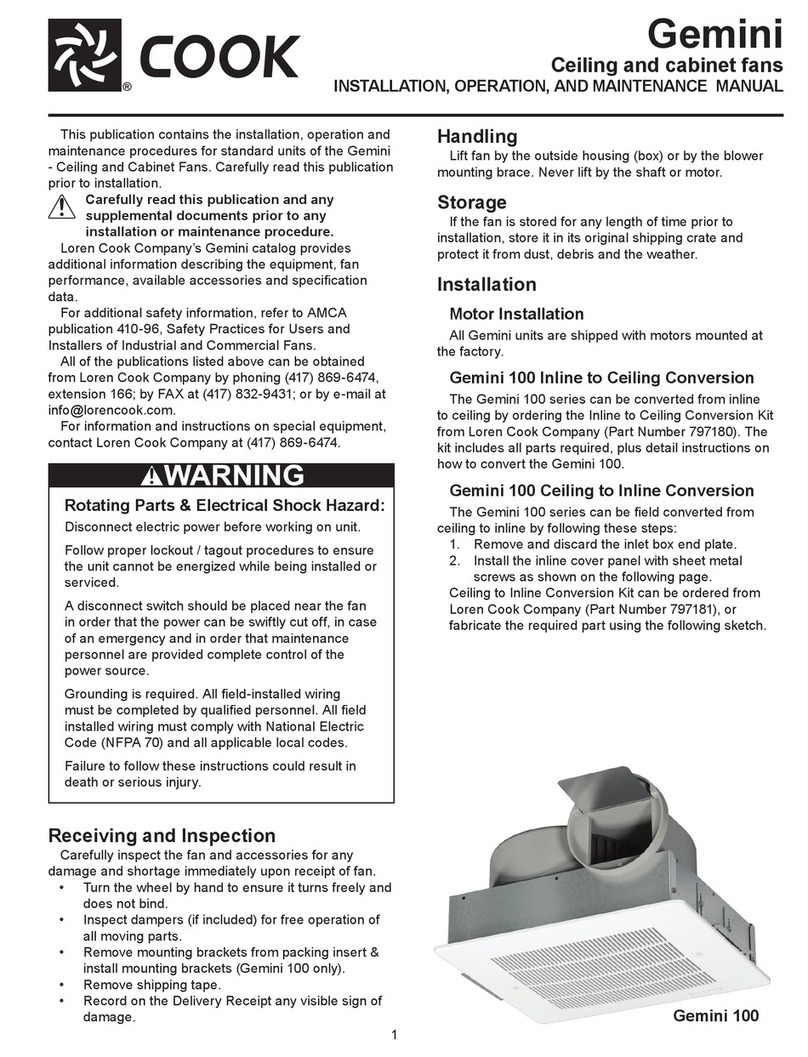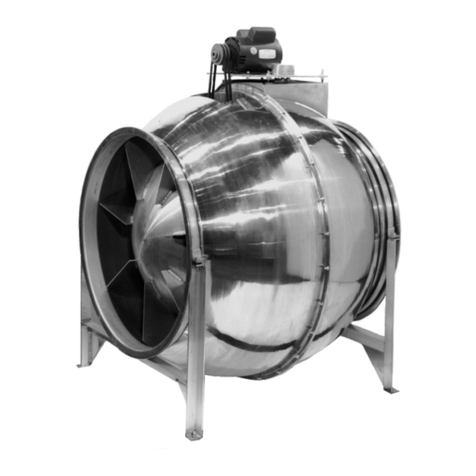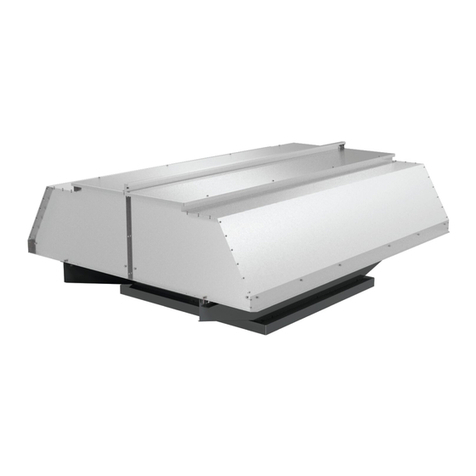
PROPELLER UPBLAST IO&M B51071-0056
Pulley and Belt Replacement
1. Clean the motor and fan shafts.
2. Loosen the motor plate mounting bolts to relieve the belt
tension. Remove the belt.
3. Loosen the pulley setscrews and remove the pulleys from
the shaft. If excessive force is required to remove the pul-
leys, a three-jaw puller can be used. This tool, however,
can easily warp a pulley. If the puller is used, inspect the
trueness of the pulley after it is removed from the shaft.
The pulley will need replacement if it is more than 0.020
inch out of true.
4. Clean the bores of the pulleys and place a light coat of oil
on the bores.
5. Remove grease, rust and burrs from the shaft.
6. Place fan pulley on the fan shaft and the motor pulley on
the motor shaft. Damage to the pulleys can occur when
excessive force is used in placing the pulleys on their re-
spective shafts.
7. After the pulleys have been correctly placed back onto
their shafts, tighten the pulley setscrews.
8. Install the belts on the pulleys. Align and adjust the belts
to the proper tension as described in Belt and Pulley In-
stallation, page 2.
Bearing Replacement
1. The fan bearings are pillow block ball bearings.
2. Remove the wind band and damper assembly to gain ac-
cess to the fan.
3. Loosen the motor plate mounting bolts and remove the
drive belts.
4. Remove the propeller from the shaft.
5. Remove the bearing cover. Remove the four (4) bearing
hold-down bolts and then remove the shaft, bearings, and
driven sheave from the unit as an assembly.
6. Measure and record the location of the bearings and
sheave on the shaft. This will aid the reassembly.
7. Remove the anti-corrosion coating from the shaft with a
suitable degreaser and then remove the pulley from the
shaft. An emery cloth or le may be needed to remove im-
perfections in the shaft left by the setscrews.
8. Remove the bearing from the shaft using a bearing puller.
9. Clean the shaft and bearing bores thoroughly.
10. Place the bearings into position making sure they are not
on a worn section of the shaft. Tapping the inner ring face
with a soft driver may be required. Tighten the setscrews
on the lower bearing.
11. Install the pulley in the correct location on the shaft. Se-
cure the bearing hold-down bolts, but do not fully tighten.
12. Align the setscrews on the top bearing with those on the
lower bearing. Tighten one of them.
13. Rotate the shaft to allow the bearing outer rings to nd
their center of free movement. If your fan is supplied with
a lube line, attach it to the grease connection.
14. Install the propeller on the shaft and adjust bearing posi-
tion to center the propeller in the opening.
15. Tighten hold-down bolts to proper torque. Refer to Rec-
ommended Torque Chart, page 4.
16. Turn the shaft by hand. Resistance should be the same as
it was before hold-down bolts were fully tightened.
17. Tighten bearing setscrews to specied torque.
18. Reassembly the fan.
After 24 hours of continuous operation, tighten the set-
screws to the appropriate torque. This assures the full locking
of the inner race to the shaft. Ensure the socket key or driver
is in good condition with no rounded corners. The key should
be fully engaged in the setscrew and held squarely to prevent
the rounding out of the setscrew socket when applying maxi-
mum torque.
Propeller and Shaft Replacement Precautions
• If the shaft is dropped and bent, it may cause unbalanced
operation of the fan
• When handling the propeller separately from the shaft,
place a support through the hub for lifting, making sure not
to injure the nished bore of the propeller
• Never allow the propeller to rest its entire weight on the
blades. The propeller and shaft can be lifted by slings
around the shaft on each side of the propeller so the propel-
ler is supported by its hub
• If using a chain to lift the propeller, make sure there is su-
cient padding on the shaft and propeller. This prevents the
scoring of the shaft or injury to the propeller. The chain or
cable should be spread with timbers, or braced by some
other method to prevent damage to the propeller side plates
Troubleshooting
Problem and Potential Cause
Low Capacity or Pressure:
• Incorrect direction of rotation. Make sure the fan rotates
in same direction as the arrows on the motor or belt drive
assembly
• Poor fan inlet conditions. There should be a straight clear
duct at the inlet
• Improper propeller alignment
Excessive Vibration and Noise:
• Damaged or unbalanced propeller
• Belts too loose; worn or oily belts
• Speed too high
• Incorrect direction of rotation. Make sure the fan rotates
in same direction as the arrows on the motor or belt drive
assembly
• Bearings need lubrication or replacement
• Fan surge
Overheated Motor:
• Motor improperly wired
• Incorrect direction of rotation. Make sure the fan rotates
in same direction as the arrows on the motor or belt drive
assembly
• Cooling air diverted or blocked
• Improper inlet clearance
• Incorrect fan RPMs
• Incorrect voltage
Overheated Bearings:
• Improper bearing lubrication
• Excessive belt tension
































